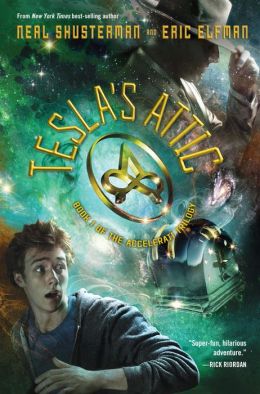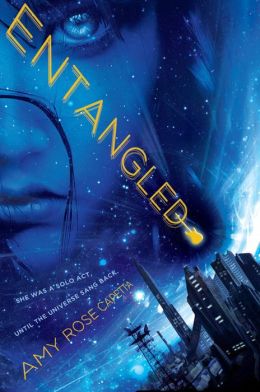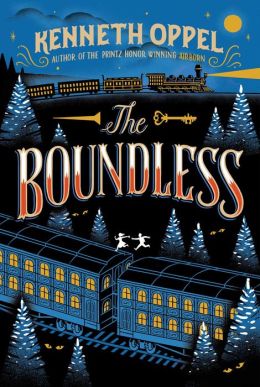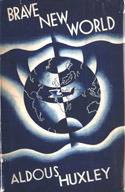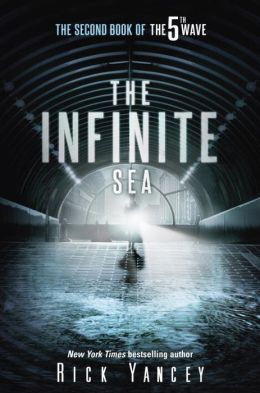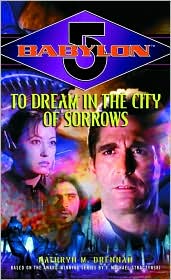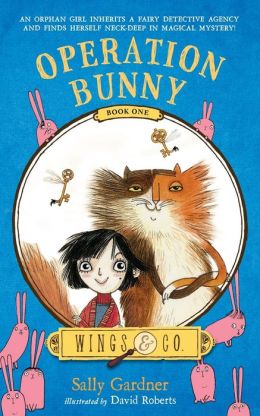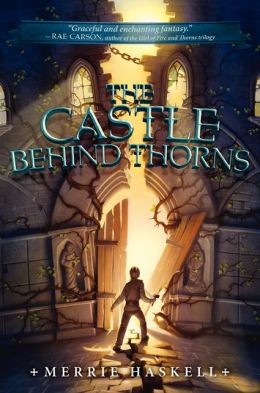new posts in all blogs
Viewing: Blog Posts Tagged with: Speculative Fiction Reviewed in 2015, Most Recent at Top [Help]
Results 1 - 11 of 11
How to use this Page
You are viewing the most recent posts tagged with the words: Speculative Fiction Reviewed in 2015 in the JacketFlap blog reader. What is a tag? Think of a tag as a keyword or category label. Tags can both help you find posts on JacketFlap.com as well as provide an easy way for you to "remember" and classify posts for later recall. Try adding a tag yourself by clicking "Add a tag" below a post's header. Scroll down through the list of Recent Posts in the left column and click on a post title that sounds interesting. You can view all posts from a specific blog by clicking the Blog name in the right column, or you can click a 'More Posts from this Blog' link in any individual post.

By:
Becky Laney,
on 3/10/2015
Blog:
Becky's Book Reviews
(
Login to Add to MyJacketFlap)
JacketFlap tags:
J Fiction,
J Fantasy,
Houghton Mifflin Harcourt,
MG Fantasy,
2013,
books reviewed in 2015,
MG Fiction,
review copy,
Speculative Fiction Reviewed in 2015,
Add a tag
How To Catch A Bogle. Catherine Jinks. Illustrated by Sarah Watts. 2013. HMH. [Source: Review copy]
I enjoyed reading How To Catch A Bogle a Victorian fantasy novel by Catherine Jinks. Birdie, the heroine, is an apprentice to Alfred the Bogler. She's bogle bait. Bogles are monsters who consume children. The action begins quickly in this one. Readers soon see Alfred and Birdie hard at work at this one. Birdie sings beautifully, baiting the trap if you will. Alfred carefully waits until just the right moment... Dangerous work it is. Is it too dangerous? One of Birdie's new acquaintances says it is. Miss Eames is something. She is very curious about bogles, about boglers. She wonders about the different types and classes of bogles--monsters or creatures. Where they live, how they live, what they eat, likes and dislikes, etc. She has a different approach than Alfred. Alfred is practical and skilled, but, not curious or scientific. Miss Eames is more interested in his work than he is in her work. She comes to really care for Birdie.
Miss Eames is not the only person interested in bogles. And there is one person whose interest is unethical....
Plenty of action and a bit of mystery!!! I enjoyed this one very much.
© 2015 Becky Laney of
Becky's Book Reviews
Tesla's Attic. (Accelerati #1). Neal Shusterman and Eric Elfman. 2014. Disney-Hyperion. 256 pages. [Source: Library]
Nick was hit by a flying toaster. Tesla's Attic is certainly different. I haven't decided yet if it's different in a good way or a bad way.
On the one hand, I loved the beginning. I thought it was fun, relatively fun anyway. Nick and his family (his dad and younger brother) have recently moved to Colorado. The move happened primarily because of a house-fire, a fire that killed the mom. No one in the family wants to stay and deal with starting over there, so the cross-country move is welcomed by everyone in the family. Nick discovers tons of junk in the attic at their new house. He decides to hold a garage sale. It happens to be raining. He doesn't expect much of a turn out, not with the weather being what it is. But surprisingly, it's a big hit. Not only are people buying things, they're insisting on paying a lot of money. By the end of the day, he's made some money but is feeling like he's in the twilight zone. Something is not right, he knows it. But what? The premise of this book is that the items in the attic were the creations, the inventions, of Nikola Tesla. The "junk" in the attic is not junk at all. It may look it. But each item does something unexpected. Like the reel-to-reel tape recorder that records WHAT YOU'RE REALLY THINKING AND NOT WHAT YOU'RE ACTUALLY SAYING. So recording conversations is interesting to say the least. The premise was unique and relatively satisfying.
On the other hand, I didn't love the ending so much. That is, by the end of the book, there were a handful of things about the book--the plot--that were bothering me. I found myself enjoying it less and less as I continued reading.
Overall, I would say this is a premise-driven novel with some entertaining scenes, but, it isn't wonderful at characterization and having depth and substance. It is an entertaining enough read, but, it isn't a great read.
© 2015 Becky Laney of
Becky's Book Reviews
Entangled. Amy Rose Capetta. 2013. HMH. 336 pages. [Source: Library]
On the one hand, I didn't end up connecting with the characters, and, I found much of the book to be confusing and/or too bizarre for my liking. But on the other hand, I found it compelling enough that I wanted to read it through until the end so that I could see if Cade 'finds' her 'entangled' missing half, Xan.
Entangled is YA Science Fiction. It's set several thousand years in the future long after Earth itself has been destroyed--by asteroid, I believe. Humans haven't done a good job colonizing space. In fact, they've done an AWFUL job of it. They're not thriving, and, at best are merely surviving. Humans are the lowest of the lowest of the low. All alien races seem to despise humans as nobodies.
Cade is the book's human narrator. She's a teen musician trying to make sense of her noisy existence. Music is the sole way she copes with her life. Her music seems to help those around her cope better with their own lives too. Even the spacesick humans who have lost their sanity completely. (The spacesick seem to have a need to touch and be touched, to connect with anything and everything outside themselves.)
Soon after the novel opens, Cade is visited by someone--or a remnant of someone. She learns that she is special, that she is 'entangled,' that she has a second-half, Xan, who is in danger, that Xan and Cade together could be the saviors of the human race. It's a lot of information to absorb. But. She takes her visitor seriously and begins a task that seems--at least to her--impossible. Finding a way off the planet and onto a space ship, traveling to the planet, Hades, where Xan is being held prisoner.
It would be a very short and unsatisfying book if Cade didn't find a way off the planet at least. And, as you might have guessed, Cade does in fact make friends with the people she's traveling with. She informs them of her mission, and, they decide to help her. Not that they offer help immediately and without reservation. But. Eventually relationships--friendships--are formed. And Cade begins to feel a little less alone and a little less overwhelmed.
There are a handful of world-building scenes throughout the novel. I'm not sure why they didn't quite work for me. I just failed to engage with this book and the characters within it. I wanted to know what happened. But I didn't necessarily "like" or "enjoy" the characters or the journey. Some characters I liked more than others.
This one may work for you. It didn't quite work for me. But as I said, I at least cared enough to finish it.
© 2015 Becky Laney of
Becky's Book Reviews

By:
Becky Laney,
on 2/10/2015
Blog:
Becky's Book Reviews
(
Login to Add to MyJacketFlap)
JacketFlap tags:
circus,
trains,
2014,
MG Fiction,
library book,
MG Fantasy,
mg historical,
MG Adventure,
books reviewed in 2015,
Speculative Fiction Reviewed in 2015,
Add a tag
Boundless. Kenneth Oppel. 2014. Simon & Schuster. 320 pages. [Source: Library]
Three hours before the avalanche hits, William Everett is sitting on an upturned crate, waiting for his father. The town doesn't even have a name yet. If you love historical action-adventures with danger and mysteries and secrets and murders, then The Boundless might be a very good fit for you, especially if you love children's books, or circuses, or trains.
The first chapter serves as a prologue. It introduces the hero, of course, Will Everett, and many of the other characters as well. Readers learn that Will loves to draw. Will meets a mystery-girl that mesmerizes him, that will continue to mesmerize him for over three years. Will meets Cornelius Van Horne, the manager of the Canadian Pacific Railroad. Will gets invited to go along on a train ride. His father, James Everett, works for the railroad, they'll meet him at the end of the line. He'll meet several people on his journey. He'll hear things, see things. For example, he'll see the plans for the Boundless, and hear of this man's visionary idea for train travel. Things happen that will change his life forever.
The rest of the novel is set three years later and covers a short span--perhaps a week. In that week, much will happen. Will, the hero, will face DANGER and have to prove himself again and again and again. Will is many things, talented, for example, but courageous not so much. He is forced to risk much, to face many different kinds of threats and dangers. He also spends much of his time thinking and pondering.
Will has one idea of his future: what he wants, what he needs. His father has another idea. The two are opposites essentially. Part of him wants to completely reject his father's plans for him. Another part is scared. So when he's not actually at risk of dying, Will ponders the future.
I liked this one. I didn't love it. But I think for those that like action-adventure, this one could prove appealing.
© 2015 Becky Laney of
Becky's Book Reviews
Brave New World. Aldous Huxley. 1932. 268 pages. [Source: Bought]
A squat grey building of only thirty-four stories. Over the main entrance the words, Central London Hatchery and Conditioning Centre, and, in a shield, the World State's motto, COMMUNITY, IDENTITY, STABILITY. Did I
love Brave New World? Not exactly. Am I glad I read it? Yes. Brave New World is a classic dystopian novel. The first half of the book seems more focused on world-building, on providing the reader with all the little details that make this future world so horrific. Not much happens but world-building. Readers meet a character or two, sure, but mostly description and information. The second half of the book, in my opinion, is where the characters become more developed. The basic premise: children are no longer
born. No more mothers and fathers. No parenting. Children are "hatched." Sometimes several thousand at a time--all identical, I believe. Conditioning begins early in an artificial womb of sorts. Every single little thing is planned and accounted for. Nothing really left to chance. The conditioning continues through childhood. Even at night. Different classes are conditioned differently, of course.
In the second half, Bernard and Lenina go on vacation together to a reservation in New Mexico. They'll get a chance to see savages first hand. They meet two savages that interest them very much. For one is a woman who grew up civilized. (Her name is Linda). She was on vacation when something happened--she became separated from the group and was left behind. She's gone native--forced to go native. She's even had to--shudder--become a mother and raise her own child. His name is John. Though, for most of the book he is simply Savage. They tell their story to Lenina and Bernard. Bernard seeks permission to bring the two back with him. All four head back to civilization--back to London. But how well will John cope with civilization?

Brave New World is both strange and thought-provoking. Also depressing. The world-building was nicely done, I believe, but I would probably need to reread it a time or two to "catch" everything and fully appreciate it. There is plenty to 'shock' that's for sure. Some scenes are just disturbing--and are meant to be disturbing or disorienting at the very least.
I did like the second half more than the first half. It's not that the second half was less disturbing--it wasn't--but the fact that the focus was more on the characters. I can't say that I "liked" or "loved" any of the characters. I pitied John the most because he felt so out of place on the reservation and so out of place in civilization. John wasn't the only memorable character either.
I can see how Brave New World inspired other writers through the decades. Anyone who reads modern dystopian novels--there are so many I could list--should consider reading this one.
Quotes:
"I don't understand anything," she said with decision, determined to preserve her incomprehension intact. "Nothing. Least of all," she continued in another tone, "why you don't take soma when you have these dreadful ideas of yours. You'd forget all about them. And instead of feeling miserable, you'd be so jolly. So jolly," she repeated and smiled..."
The world's stable now. People are happy; they get what they want, and they never want what they can't get. They're well off; they're safe; they're never ill; they're not afraid of death; they're blissfully ignorant of passion and old age; they're plagued with no mothers or fathers; they've got no wives or children, or lovers to feel strongly about; they're so conditioned that they practically can't help behaving as they ought to behave. And if anything should go wrong, there's soma.
© 2015 Becky Laney of
Becky's Book Reviews

By:
Becky Laney,
on 1/27/2015
Blog:
Becky's Book Reviews
(
Login to Add to MyJacketFlap)
JacketFlap tags:
YA Fiction,
YA Romance,
aliens,
YA Science Fiction,
2014,
Penguin USA,
library book,
books reviewed in 2015,
Speculative Fiction Reviewed in 2015,
Add a tag
The Infinite Sea (Fifth Wave #2) Rick Yancey. 2014. Penguin. 320 pages. [Source: Library]
I'm so glad I took the time to reread Rick Yancey's The Fifth Wave! I felt ready for the sequel. Of course, I felt ready for the sequel the moment I first finished The Fifth Wave! But I felt prepared to fully appreciate the sequel.
First, you shouldn't read The Infinite Sea until you've read the first book in this alien-invasion series. It does NOT stand alone.
Second, if you've read the first book, and at the very least enjoyed-it-in-the-moment, you should pick up this next book.
Third, if you're looking for a quick, compelling read--perhaps for a read-a-thon--then consider this one. What makes it quick is the fact that, like the first book, it is hard to put this one down!!!
Some time has passed--perhaps a few days, perhaps a week or two--since the ending of The Fifth Wave.
The prologue, "The Wheat," is something. I think it does a great job as prologue--reminding readers of the intensity of the series, of the world as they know it.
Book one, The Problem of Rats, "The world is a clock winding down." This first section is narrated by Ringer. I believe this was the first chance for readers to get her perspective. I was expecting the book to begin with Cassie, I almost saw The Fifth Wave, as being Cassie's book predominantly, and opening with Ringer's thoughts, well, it was a good reminder that the book, the series, is so much more than that.
Book one, The Ripping, "From the time I could barely walk, my father would ask me, Cassie, do you want to fly?" This second section is narrated by Cassie. You'll probably notice--beginning with this section--that the chronology of the narrators is interesting and overlaps and goes back and forth a bit. I didn't mind this actually.
Book one, The Last Star, "As a child, he dreamed of owls." Evan Walker gets his chance to narrate. Readers learn much in this section!!!
Book one, Millions, "The boy stopped talking the summer of the plague." I found this section--short as it was--to be so emotional. I loved gaining more insight on Poundcake.
Book one, The Price. This fifth section is narrated by Cassie. I wouldn't say it's the most action-packed section, but that's because it would be too tough to choose. Has there really been a slow section?! But much does happen, and we see it through her point of view.
Book one, The Trigger. Again. So very short. But oh-so-intense. Another Poundcake section. And I thought "Millions" was emotional!
Book two, The Sum of All Things. Ringer's section. Plenty of this novel is told through her perspective, and, I came to appreciate that in a way. Much is learned in this section certainly, or, perhaps I should say much is explained through dialogue?
Book two, Dubuque. Essentially the conclusion of the book. Cassie's perspective, I believe.
© 2015 Becky Laney of
Becky's Book Reviews

By:
Becky Laney,
on 1/25/2015
Blog:
Becky's Book Reviews
(
Login to Add to MyJacketFlap)
JacketFlap tags:
favorite books,
adult fiction,
Orson Scott Card,
Adult Science Fiction,
Adult Fantasy,
book I bought,
books reviewed in 2015,
books reread in 2015,
Speculative Fiction Reviewed in 2015,
Add a tag
The Worthing Saga. Orson Scott Card. 1990. Tor. 465 pages. [Source: Bought]
In many places in the Peopled Worlds, the pain came suddenly in the midst of the day's labor. It was as if an ancient and comfortable presence left them, one that they had never noticed until it was gone, and no one knew what to make of it at first, though all knew at once that something had changed deep at the heart of the world. This will be my third blog review for Orson Scott Card's The Worthing Saga. I reviewed
this one in 2007 and
2012. It is one of my favorite, favorite books. And my FAVORITE Card novel. (Though I love Ender's Game and Speaker for the Dead.)
I love the world-building. I find the three settings within the book to be fascinating. (There is Lared's home planet which is the present-day setting; there is Capital, the planet from Jason Worthing's memory and stories, Capital becomes "real" to Lared as he experiences Worthing's memories through dreams; there is Worthing, the planet that Jason colonized with a handful of colonists thousands of years before the novel opens, again this planet becomes "real" to Lared as he experiences other people's memories through Justice, Jason's descendent.) Readers get a taste of all these societies and communities. Capital is decadent and immoral and corrupt. It is obsessed with the notion of eternity--of living forever. It "lives forever" by drug use. Somec. You might be under Somec--asleep--for anywhere from one year to ten years, and then awake for anywhere from one day (like the Empress) to three years. But somec disrupts EVERYTHING good and natural about life. An example of the decadence and immorality can be seen in the "lifeloops." People filming/recording their "real" lives for everyone to watch. Most--if not all lifeloops--are graphic in nature. It's hard not to be disgusted by the depiction. (For example, one actress complaining to her agent that he better not hire any seven year old boys for her next film.) Closely connected to the world-building, is the mythology of it. How Abner Doon's name lives on. He IS the devil. How Jason Worthing's name lives on. How people see him as being GOD. Both men are very much human, having strengths and weaknesses, being oh-so-fallible. But they have become collectively so much more than that. They've lost their humanity. Truth has been shaped and reshaped too many times to allow for them to be just human.
I love the characterization. I love getting to know Lared, Sala, Jason, and Justice. Not to mention all the men and women from the memories and stories. (I have a soft spot for Hoom.) I love the storytelling. I love the dialogue. I love how everything is layered together. How the story all comes together. How Lared slowly but surely pieces things together and comes to understand--if understand is the right word--the world. Card's characters are so very human, so vulnerable, so fallible. Readers see humans at their best and at their absolute worst within The Worthing Saga. Moments of compassion and redemption make it so worth while.

I love the ideas. I love the depth and substance. That is not to say that I agree absolutely with every single philosophical idea within the book. But it goes places most fiction doesn't. It asks real questions, tough questions. It explores ideas. One also sees the consequences (or possible consequences) of ideas. But it encourages you to think about deep things, to explore questions like
why is there pain? why is there suffering? would the world be a better place without pain, without suffering? Is pain a necessary evil? Do we only feel joy and happiness because we know about pain and sorrow? what makes life beautiful? do we become better people through our struggles with life?I do enjoy the framework. The Worthing Chronicle (1982) makes up half of The Worthing Saga. This is THE story with Lared being visited by Jason and Justice shortly after the day of pain disrupts his community. (It really is a haunting opening.) The second half of the book consists of short stories. Most of these short stories were written years before The Worthing Chronicle and were previously published. Tales of Capitol (1979): "Skipping Stones," "Second Chance," "Lifeloop," "Breaking the Game," "Killing Children," and "What Will We Do Tomorrow." Tales from the Forest of Waters (1990, 1980): "Worthing Farm," "Worthing Inn," and "The Tinker." Of these stories, I find Skipping Stones, Second Chance, and Breaking the Game to be most memorable. After you've read these stories, you almost need to go back and reread the first section. I'm not sure you can fully appreciate the book without rereading it a few times and absorbing it. Most of the stories--but certainly not all of them--are emotional. I love that the book is a book to be EXPERIENCED.
© 2015 Becky Laney of
Becky's Book Reviews
To Dream in the City of Sorrows. (Babylon 5: Book #9). Kathryn M. Drennan. Based on the series by J. Michael Straczynski. 1997. Random House. 352 pages. [Source: Bought]
"What are we to do with him her?" asked the Mole of the Water Rat.
"Nothing at all," replied the Rat firmly. "Because there is really nothing to be done. You see, I know him her from old. He She is now possessed. He She has got a new craze, and it always takes him her that way, in its first stage. He'll She'll continue like that for days now, like an animal walking in a happy dream, quite useless for all practical purposes. Never mind him her. ~ Adapted from Wind of the Willows
Me obsessed with Babylon 5?! Really?! Perhaps.
I've read To Dream in the City of Sorrows three times now. I reviewed it in
2011 and
2012. I think it is a must read for fans of Babylon 5. In the introduction, J. Michael Straczynski writes, "What you hold in your hand is an official, authorized chapter in the Babylon 5 story line. This is the definitive answer to the Sinclair question, and should be considered as authentic as any episode in the regular series."
But where to place it?! That is the question. It's tempting to read it in between season one and season two. After all, most of the book's events are parallel to season two. Readers get a chance to read what Sinclair is doing in the meantime. But not
all the events, and that is where it gets tricky. Reading To Dream In the City of Sorrows before viewing season three would spoil things for you. So reading it after you've seen the third season may prove best. Since I've seen most all the seasons multiple times, I read it when I like! [For the record, this time around, I've seen all of season one, and the first eight episodes of season two.]
So the framework of To Dream In The City of Sorrows--the prologue and epilogue--take place shortly after season three's "Grey 17 is Missing," and are narrated by Marcus Cole. (I just LOVE, LOVE, LOVE Marcus Cole!) But most of the book focuses on what was happening with Jeffrey Sinclair after he left Babylon 5. (The gap between the last episode of season one, "Chrysalis," and the incredibly intense two-part episode "War Without End" of season three.)
Read To Dream in the City of Sorrows
- If you want to know what Sinclair was doing in season two and three
- If you want to know what became of Catherine Sakai, to learn if these two were able to make their troubled relationship work...with the added drama of Shadows and Rangers
- If you want to know more even more about the Shadows' movements during this time
- If you want to learn about how Sinclair became Ranger One and re-energized the Rangers (first started by Valen)
- If you want to learn more about Minbari prophecies (also their culture and caste system)
- If you want to learn more about the Vorlons; in particular readers are introduced to Ulkesh. (Loved Sinclair's first impression of him! And his insights about the Vorlons in general. How Kosh may not be the most representative of his race.)
- If you want to learn more about Marcus. Readers meet William Cole AND Marcus Cole. Two brothers with an imperfect relationship. William is an eager ranger-in-training trying to get Marcus to join him, but, things don't always go as planned.
© 2015 Becky Laney of
Becky's Book Reviews
Operation Bunny. Sally Gardner. Illustrated by David Roberts. 2014. Henry Holt. 192 pages. [Source: Library]
I loved Operation Bunny. I loved it so much more than I thought I would. I loved it because it was just fun. Emily Vole, the heroine, was abandoned as an infant. She was left in a hatbox. She was adopted soon after she was found. (At first, authorities thought she was a bomb. That is they thought the hatbox contained a bomb.) But her adopted parents are truly awful which is somewhat typical in fantasy novels for children! As I was reading, I was reminded again and again of The Willoughbys by Lois Lowry. I LOVED that book. So it was a good sign for me! They were bad parents before the mom found out she was having triplets. After the triplets were born, well, things get strange in a horrid way. (They move her to the laundry room. Her bed is the ironing board.) Emily doesn't go to school. She's too busy earning her keep as a housekeeper. Of course, her mom gets upset that Emily never finishes all the chores on her list. The dad, for once, points out wisely, well, she can't read, dear. But. Things begin to look brighter for "poor Emily" once she meets the neighbor-next-door, Miss String, and the cat-next-door, Fidget. I just want to say that I LOVE, LOVE, LOVE, LOVE Fidget (the talking cat). So this adventure-fantasy properly begins when Emily meets Fidget and Miss String and they learn that there's something very special about Emily! Of course, I could go on to tell of the villain and the evil plot...but I won't. I want you to discover this one yourself!
Operation Bunny is the first in a new series. I loved it and would definitely recommend it.
© 2015 Becky Laney of
Becky's Book Reviews

By:
Becky Laney,
on 1/13/2015
Blog:
Becky's Book Reviews
(
Login to Add to MyJacketFlap)
JacketFlap tags:
library book,
MG Fantasy,
books reviewed in 2015,
Speculative Fiction Reviewed in 2015,
HarperCollins,
fairy tales,
J Fiction,
J Fantasy,
2014,
MG Fiction,
Add a tag
The Castle Behind Thorns. Merrie Haskell. 2014. HarperCollins. 336 pages. [Source: Library]
Sand woke, curled in the ashes of a great fireplace. Surprised to find himself waking at all, for he had no memory of falling asleep, Sand scrambled to his feet. Soot billowed from him in a cloud and sneaked up his nose. He sneezed four great sneezes that came back in lonely echoes from the vast room beyond the fireplace. Sand had never slept in a fireplace before. He never wanted to again. But he hesitated inside the fireplace, one foot suspended in midair, afraid to leave. In the room beyond, everything was broken. Every single thing.I loved, loved, loved The Castle Behind Thorns. It is a retelling of Sleeping Beauty, I suppose. It puts a definite spin on it that is completely different from the original, but that is completely fascinating. Sand, the hero, wakes up in a fireplace in a castle that he's only heard stories about. The castle being abandoned quite suddenly when his own father was not yet grown. He finds himself very alone; he's the only living thing in the castle. (No growing plants, no bugs or insects, no birds, no mice, nothing). He keeps the panic to a minimum, in my opinion. Especially considering the situation! He's in an abandoned castle surrounded by hostile, vicious thorns. He explores. He plans. He mends. He learns and adapts. He's hungry and thirsty and tired. He finds a way to survive. In his exploring, he finds the family's crypt. He restores a body that had fallen, placing the young girl's body back gently and carefully. Several days later, or some time later, readers meet the heroine Perrotte...
The Castle Behind Thorns is a beautiful story with memorable, well-developed characters. I enjoyed every minute of this one! The mystery is quite good! I would definitely recommend this one!
Read the Castle Behind Thorns
- If you enjoy fairy tale retellings
- If you enjoy good/great storytelling
- If you like fantasy novels with a touch of magic
- If you like mysteries
- If you like survival stories
© 2015 Becky Laney of
Becky's Book Reviews
It's The End of the World As We Know It. Saci Lloyd. 2015. Hachette Books. 288 pages. [Source: Review copy]
Did I like Saci Lloyd's
It's The End of the World As We Know It? Not really. The book is described as surreal and hilarious. And. For some readers, I suppose it might read enough like Douglas Adams to pass as a good read. But overall, I was irritated and frustrated.
The book is science fiction and deals with alternate universes and wormholes. The particular alternate universe readers will experience in the book was created mostly by accident. The mad scientist, Xenron Deva, meant to do something, no doubt, but a strand of hair, leads to complete nonsense in the world he did create. The Deva Corporation did not even remain in power long, for at the time, our hero gets sent there by accident, the world is being managed or mismanaged by KAT. The world is strange and bizarre, which readers might expect and actually prefer. But the differences in spelling, in particular, drove me crazy.
Mikey Malone is the hero of It's the End of the World As We Know It. While trying to impress a girl, Caitlyn, he fakes interest in internet celebrity-hacker-spy GERILLR. Ultimately, he regrets this I think. Since it is during their time together waiting for GERILLR's program/broadcast that he is sucked into this alternate reality. (So is the parrot, Ubu).
Mikey soon finds himself in a strange, strange place: Silikon Valle. And it takes him a bit to adapt and make friends. (Only a few of his friends have names that are easy to type.) Conflict, the book has plenty of it. Mikey, of course, wants to find out a way to get back to his own reality, his own home. And that won't be easy. For not only is he clueless, he's also being hunted/attacked by bad guys. Teamwork can accomplish plenty, but, no matter how hard one tries, sometimes endings are imperfect.
I found the book annoying and unsatisfying. But you might find it entertaining. Especially if you don't mind endings that aren't proper endings.
© 2015 Becky Laney of
Becky's Book Reviews




